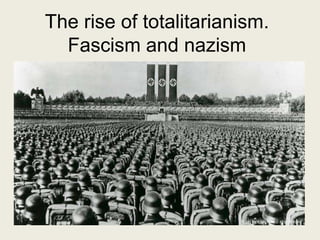
3. The rise of totalitarianism. fascism and nazism
- 1. The rise of totalitarianism. Fascism and nazism
- 2. - In the years between the two world wars, some people in Europe thought that democracy and the liberal system had failed because of: - The outbreak of WW I - The Great depression - Some countries (especially Germany and Italy) adopted totalitarian regimes with one party that had total control over society. - However, after the Great depression democracy remained in France, the United Kingdom, the Netherlands and the Scandinavian countries.
- 3. Who supported the totalitarian regimes? • Workers of the middle classes who had experienced the decrease in their standard of living due to the Great depression. • Important business men who did not want communism to spread in their country. • Unemployed people. • The conservative sectors of society who did not agree with democracy (including many members of the military).
- 4. What is a totalitarian state? • In a totalitarian state there is only one political party (nazi party in Germany, fascist party in Italy), and there is not democracy or elections. • The party and the state was led by a leader: Hitler in Germany (the führer) and Mussolini in Italy (Il Duce). Being obedient to the leader was out of the question. • There was no freedom of speech. • The opposition to the leader or the party was considered as treason to the State, so violence was widely used to repress the protesters who did not agree with the totalitarian state.
- 5. • Propaganda was widely used. Education was controlled by the State. • Symbols, songs and uniforms were used to unify the followers. • The totalitarian regimes were anti-communist and anti-capitalist, although later they accepted capitalism. • The country came first; the individual, arterwards. Totalitarians were ultranationalist. • The country needed to expand territorially so that the nation could survive. Thus, the country had to have a strong army.
- 6. Fascism in Italy • Reasons for the rise of fascism in Italy: - dissatisfaction with the territories Italy received after WW I. - high unemployment, and rise of the comunist party. This frightened the rich, who feared communism to spread. Thus, they supported Mussolini because he promised order (although using violence).
- 7. Benito Mussolini was the leader of the Italian fascists. He created a group of paramilitary groups (the blackshirts) to repress the workers’ protests, and the communist who supported them. King Victor Emmanuel III also supported Mussolini.
- 8. In 1922, Mussolini and his black shirts marched over Rome to press the king to appoint him prime minister. And the king accepted.
- 9. Once in power, Mussolini established a fascist state: - freedoms were restricted. - political parties were banned. - trade unions and any opposition were repressed violently. - the State directed the economy.
- 10. Nazism in Germany • After WW I, the German empire disappeared. A democratic republic was created: the Weimar Republic (1918-1933). • But Germany was deeply affected after WW I: - the country’s economy was stagnant because of the repairs the country had to pay. - the Great depression made the economic situation worsen. - many people felt humiliated after the country had accepted the Treaty of Versailles.
- 11. The nazi parti • The National Socialist German Worker’s party (or ‘the nazis’) criticised the situation of Germany after WW I. • Some of its members (the SA) marched in the streets, and usually used violence to scare the population.
- 12. The nazi party • Adolf Hitler (who had been born in Austria) became leader of the German nazi party in 1921. • Hitler managed to attract the attention of unemployed people, the rich and urban workers. • He was a racist who maintained that the country should get rid of any person of Jewish or non- aryan origin, and he defended a totalitarian state with a strong central government which would force all citizens to adhere to the nazi ideology. • He criticised the Weimar republic, and democracy.
- 13. How did the nazis reach power? • The nazis had not received much support before 1929. • However, the Great Depression hit Germany and impoverished the population. • That’s the moment when Hitler managed to attract the most votes. • In the elections of 1932, the nazi party received millions of votes. Hitler was appointed chancellor of Germany in January 1933.
- 14. The nazis in power • The Weimar republic and democracy were abolished. • A fierce dictatorship was established. Political parties and trade unions were banned. • Fundamental rights were eliminated. • The Jews were discriminated and persecuted. According to Hitler’s mad ideas, the Jews were responsible for the situation of economic crisis Germany was experiencing. • Any opposition was repressed by the political police (the Gestapo). Censorship was established. • Education was controlled by the state. Propaganda was reinforced against the Jews and the communists.
- 18. The economy during the nazi period • During the nazi totalitarian state, the economy was controlled by the government. • The government promoted the production of cars (Volkswagen), weapons and the metallurgy. • The economy improved, although workers had to suffer cuts in their rights and salaries.